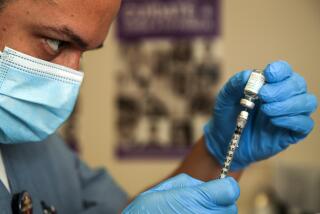120 New HIV Cases Recorded in Last 2 Months
- Share via
In the two months since Ventura County began recording the number of new HIV cases to better track the spread of the virus that causes AIDS, 120 new cases have been reported.
And county public health officials estimate there may actually be as many as 1,200 cases locally.
As of July 1, state public health officials are requiring doctors and laboratories to report new cases of HIV as well as new cases of AIDS. The county began monitoring new cases in May.
Public health authorities hope to better understand how many new cases of HIV are occurring and what groups are being affected and to target their education and outreach efforts to those groups.
“In the past, we only reported the tip of the iceberg--people who were already sick [with AIDS],” said Dr. Robert Levin, the county’s medical health director. The California Department of Health Services has recorded 347 patients with AIDS in the county, but without tracking the number of new HIV infections, public health officials were unable to truly follow the spread of the virus, Levin said.
Under the new system, doctors and laboratories use an alphanumeric code to report new HIV cases, instead of reporting the patient’s name. Patients tested at sites where they do not provide their names are not included in the county’s records of new cases.
County public health officials say it is too soon to determine any definite trends from data compiled from the first 81 reported cases in the county. But they said the data fit existing patterns of HIV infection and that the rising numbers indicate a growing need to increase HIV and AIDS awareness in the community.
The data show the majority of the patients were between the ages of 20 and 40 and had contracted the virus through sexual contact. Twice as many males as females were infected.
Diana Goulet, project director for Ventura’s HIV/AIDS Program, said she has also seen an increase in the number of new HIV cases among Latinos.
Data from the county showed that 30 of the first 81 patients were Latino.
“The biggest increase we’re seeing, given the limited data on HIV disease, is in the Hispanic/Latino population,” Goulet said. “We certainly need to get the message out to that population that they are at risk and what the risk behaviors are, and how to protect themselves.”
But getting that message out is a challenge, said Bruce Bradley, a spokesman for Ventura County Rainbow Alliance. The organization promotes HIV and AIDS awareness among the gay and lesbian community, even going so far as to have a “cyber-outreach” worker who enters chat rooms to discuss safe sex.
Bradley knows of six clients who have died of AIDS since February, but with more people living longer with HIV, he said it’s difficult to get people to understand the severity of the virus and the need to avoid risky behaviors.
“When you’re combining your message with people going to funerals, it’s pretty powerful,” Bradley said. But now, “the message doesn’t have the same effect that it once did.”
Goulet added that media coverage of new HIV medications has led some people to believe the virus is curable.
But people need to realize that it isn’t, and that no one is immune, she said.
“[HIV] continues to spread because there is a little bit of [an attitude] of ‘Just this once won’t hurt’ or ‘It won’t happen to me,’ ” she said. “But everyone is at risk.”
More to Read
Sign up for Essential California
The most important California stories and recommendations in your inbox every morning.
You may occasionally receive promotional content from the Los Angeles Times.













